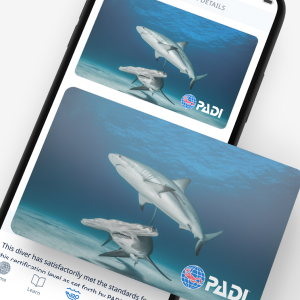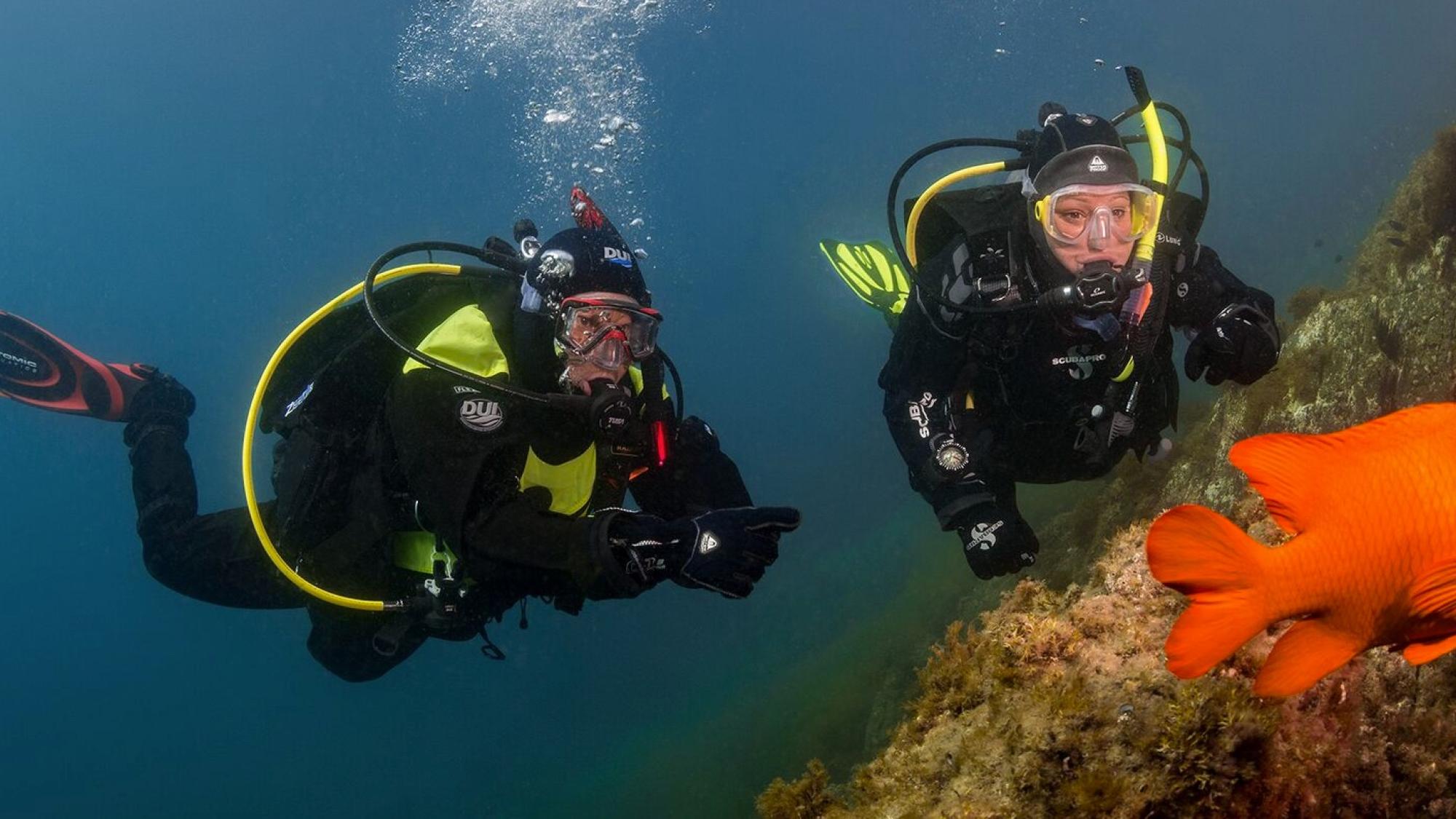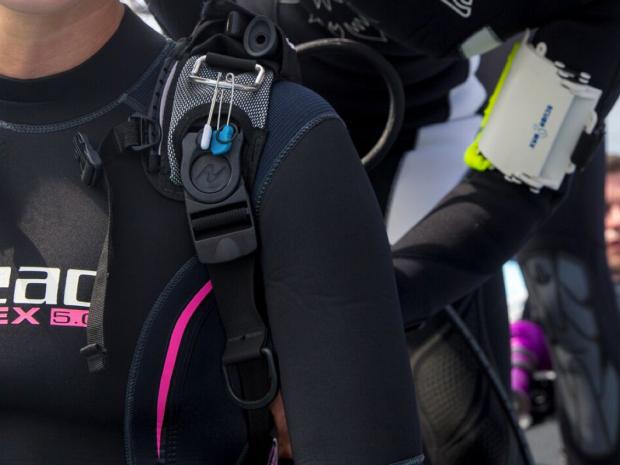ออกแบบมาสำหรับน้ำที่เย็นกว่า ชุดดรายสูท (Dry Suit) จะสร้างซีลรอบข้อมือและคอของคุณเพื่อป้องกันไม่ให้น้ำไหลเข้าและทำให้ตัวคุณแห้ง
คำอธิบาย
ชุดดรายสูทจะช่วยให้คุณแห้งโดยสร้างซีลที่ข้อมือและคอของคุณ เนื่องจากรองเท้าบูทของคุณมักจะติดอยู่กับชุด คุณจึงต้องรักษาความอบอุ่นให้ศีรษะและมือของคุณด้วยหมวกคลุมศีรษะและถุงมือ ชุดดรายสูทช่วยให้คุณรู้สึกสบายตัวมากขึ้นในอุณหภูมิผิวน้ำที่เย็นกว่าและลมแรง เยี่ยมชม Scuba Diving Magazine สำหรับทุกสิ่งที่คุณต้องรู้เกี่ยวกับชุดดรายสูทในที่เดียว รวมถึงคู่มือการเลือกซื้อ รีวิวเปรียบเทียบและคู่มือการใช้งาน
Standard Features
- ชุดดรายสูทชุดต้องมีซิปกันน้ำแบบพิเศษ ชุดดรายสูทที่มีซิปอยู่ด้านหลังตรงไหล่อาจต้องใช้ความช่วยเหลือจากผู้อื่นในการสวมใส่และถอดออก มีชุดสูทหลายแบบที่มีซิปซึ่งถูกออกแบบให้สามารถสวมใส่ได้ด้วยตัวเอง
- ซีลที่ข้อมือและคอต้องแนบสนิทกับผิวหนังของคุณเพื่อป้องกันน้ำเข้า แต่ไม่แน่นเกินไปเพื่อหลีกเลี่ยงปัญหาการหายใจหรือการไหลเวียนของเลือด
- หากต้องการเติมอากาศขณะที่คุณลงสู่ความลึกและปล่อยอากาศขณะที่คุณขึ้นสู่ความตื้น ชุดดรายสูทของคุณจะต้องมีตัวเติมอากาศและวาล์วระบายอากาศ ดรายสูทบางชุดมีวาล์วระบายที่ข้อมือและบางชุดมีวาล์วที่ไหล่หรือวาล์วระบายอัตโนมัติ
สไตล์ของชุดดรายสูท
- ชุดดรายสูทนีโอพรีนทำจากวัสดุเดียวกันกับชุดเว็ทสูท เพียงแต่ว่าชุดชนิดนี้สามารถกันน้ำได้ มันแนบกระชับกับร่างกายของคุณ ให้การป้องกันอุณหภูมิที่ดีเยี่ยมและลอยน้ำได้ดี
- ชุดดรายสูทเชลล์ (Shell) หมายถึงการที่เปลือกนอกช่วยกันน้ำไม่ให้ซึมเข้า แต่คุณต้องสวมเสื้อหรือชุดชั้นในไว้ข้างในเพื่อให้ความอบอุ่น — หากน้ำเย็นมาก ควรใส่เสื้อหรือชุดชั้นในหนาขึ้น หรือหากน้ำอุ่นหรืออุณหภูมิปานกลาง ก็ใช้เสื้อหรือชุดชั้นในที่บางเพื่อป้องกันความเย็น
Optional Features
- แผ่นรองเข่า แผ่นรองข้อศอกและแผ่นรองนั่ง เพื่อปกป้องบริเวณเหล่านี้ของชุดดรายสูทของคุณให้ดียิ่งขึ้น
- กระเป๋าเป็นประโยชน์สำหรับสิ่งของ เช่น แผ่นสเล็ท และมักจะอยู่บริเวณต้นขา
- ผู้ผลิตบางรายมีตัวเลือกในการเชื่อมต่อฮู้ดเข้ากับชุดดรายสูทเพื่อเพิ่มความอบอุ่น
- ชุดดรายสูทบางรุ่นมีส่วนปิดเท้าที่ช่วยให้คุณสามารถสวมรองเท้าบูททับได้
How to Choose
หากคุณดำน้ำในบริเวณที่อุณหภูมิของน้ำหรืออากาศทำให้จำเป็นต้องใช้ชุดดรายสูท หรือแม้แต่ในกรณีที่ต้องการใช้ชุดดังกล่าว อย่าลังเลที่จะขอคำแนะนำและขอความช่วยเหลือจากมืออาชีพด้านการดำน้ำที่ศูนย์ดำน้ำ PADI ของคุณ จากนั้น เข้าร่วมหลักสูตร PADI Dry Suit Diver Specialty เพื่อเรียนรู้เกี่ยวกับการเลือก การใช้และการดูแลชุดดรายสูท
- เลือกสไตล์ชุดดรายสูทของคุณตามสภาพการดำน้ำในพื้นที่ของคุณและคำแนะนำจากมืออาชีพด้านการดำน้ำของคุณ
- หาขนาดที่พอดี โดยปกติจะมีตั้งแต่ XS ไปจนถึง XL เลือกเสื้อหรือชุดชั้นในที่คุณจะใช้และลองสวมชุดหลาย ๆ ชุดพร้อมกับเสื้อหรือชุดชั้นในของคุณ
- เสื้อหรือชุดชั้นในที่ทำจาก ThinsulateTM หรือ Polartec® หรือวัสดุสังเคราะห์ที่คล้ายกัน ค่อนข้างบางและให้ฉนวนกันความร้อนได้อย่างมีประสิทธิภาพแม้จะเปียกก็ตาม
- เสื้อหรือชุดชั้นในหลายชนิดช่วยระบายเหงื่อออกจากผิวของคุณ มองหาเสื้อผ้าที่มีชั้นนอกซึ่งกันลมและกันน้ำ
- ประเมินความพอดี รวมถึงความสบายของรองเท้าบูท ความกระชับของข้อมือและคอ ความง่ายในการรูดซิป ความง่ายในการกดปุ่มเติมอากาศและปุ่มปล่อยอากาศขณะสวมถุงมือ และความง่ายในการเคลื่อนไหวขณะสวมใส่
- จำกัดตัวเลือกของคุณตามความพอดีและความสบาย จากนั้นให้ตัดสินใจขั้นสุดท้ายโดยพิจารณาจากสไตล์ สี คุณสมบัติเสริมและความชอบส่วนบุคคล ชุดดรายสูทนั้นเป็นการลงทุนครั้งใหญ่ ดังนั้นคุณจึงต้องการชุดที่เหมาะสม อย่าลืมซื้อเสื้อหรือชุดชั้นในของคุณด้วย
Maintenance
- หลังจากการดำน้ำ ให้ล้างชุดดรายสูทของคุณด้วยน้ำสะอาด แต่ต้องแน่ใจว่าปิดซิปให้สนิทเพื่อป้องกันน้ำเข้าไปข้างใน หากมีน้ำอยู่ภายในแล้ว ให้ล้างด้านในด้วย
- ล้างน้ำผ่านวาล์วเติมและวาล์วปล่อยอากาศ
- ให้ใส่ใจกับซิปเป็นพิเศษ หากสกปรก ให้ทำความสะอาดอย่างเบามือด้วยแปรงที่นุ่มและน้ำสบู่
- แขวนชุดดรายสูทของคุณให้แห้งห่างจากแสงแดดโดยตรง เช็ดภายในให้แห้งก่อนถ้าคุณทำการล้าง โดยกลับด้านอย่างเบา ๆ ให้ด้านในออก
- ทำการหล่อลื่นซิปตามที่ผู้ผลิตกำหนด
- เก็บชุดดรายสูทโดยพับอย่างเบามือตามที่ผู้ผลิตแนะนำ คุณสามารถสอดซีลยางลาเท็กซ์เข้าไปในแขนและลำตัวของชุดดรายสูทเพื่อช่วยปกป้องชุดดรายสูทได้
- หากคุณจำเป็นต้องซักเสื้อหรือชุดชั้นใน โปรดปฏิบัติตามคำแนะนำของผู้ผลิต เนื่องจากผงซักฟอกบางชนิดอาจทำลายคุณสมบัติการป้องกันความร้อนได้ เก็บเสื้อหรือชุดชั้นในบนไม้แขวนที่กว้าง







 เศษซากทะเล
เศษซากทะเล
 ยพันธุ์ฉลามและกระเบนที่เสี่ยงต่อการสูญพันธ์ุ
ยพันธุ์ฉลามและกระเบนที่เสี่ยงต่อการสูญพันธ์ุ
 Adopt The Blue
Adopt The Blue














